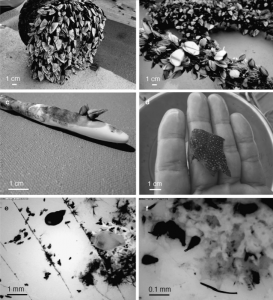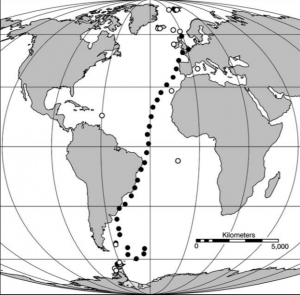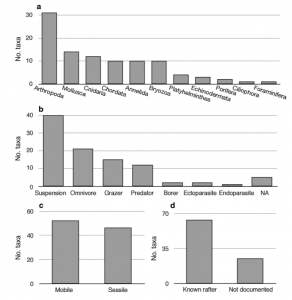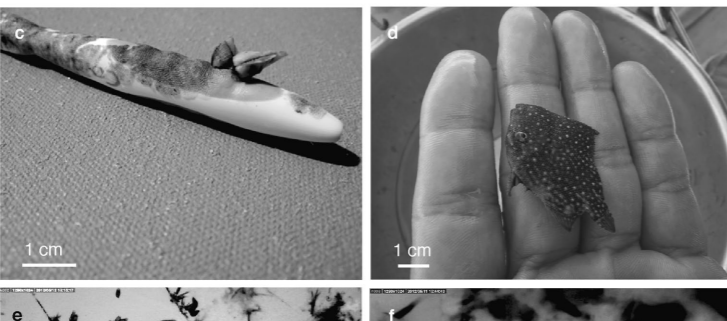Ocean Plastics
By: Nick Martinez, SRC Intern
The world’s oceans face a variety of challenges ranging from rising sea levels and sea surface temperatures, to overfishing and excessive amounts of anthropogenic debris being tossed into the oceans. Many studies have focused on the large scale effects of each of these dire issues, yet few have ventured into the realm of marine plastics and how these objects actually aid in the dispersal and recruitment of various species throughout the oceans of the world. Since the earliest known recording of anthropogenic waste in the world’s oceans back in the 1970’s (Goldstein et al. 2014), scientists have begun paying particular attention to the way many sessile species have proven to be a key foundation species in the recruitment and dispersal of various organisms throughout the world. Due to the anatomy of these sessile species, scientists have found a variety of microecosystems thriving on the surface of these plastics. Barnacles and other sessile species turn the smooth, unprotected surfaces of the plastics into a more structured surface where rafting organisms can hide and seek shelter from the otherwise harsh pelagic conditions. Because these ocean plastics have been virtually transformed by sessile organisms, these plastics and other anthropogenic debris augment a natural floating substrate in the open ocean, allowing “islands” of substrate-associated organisms to persist in an otherwise unsuitable habitat (2014). In other words, these sessile species have been able to successfully recruit and colonize these ‘floating islands,’ granting them the unique opportunity to create an environment where other organisms can survive and travel vast distances across the Pacific and Atlantic oceans (Fig 1). While this is certainly a unique way of nature overcoming one of our many detrimental anthropogenic effects, there is in fact a small trojan horse that this feat of nature carries throughout the world’s oceans. With the ability to travel vast distances across the ocean, scientists have begun uncovering the major issue of invasive species dispersal and global disease spread between the ‘floating islands’ and foreign ecosystems. To understand exactly how this is possible, a closer look into the plastics and their superiority over biotic debris must be taken into account.

Figure 1. In boxes a, b and c we can see a collection of barnacles that have colonized the various plastic substrates. In box d, we see a small trigger fish that has made the floating debris its home. In boxes e and f we see a close up view of the lethal folliculinid ciliates that cause skeletal eroding band disease in corals (Gill and Pfaller 2016).
For hundreds of millions of years, organisms have had limited travel on floating marine algae, plant trunks, pods, or other biotic floating parts (Barnes et al. 2004). In fact, scientists were previously aware of marine organism dispersal to other parts of the world via debris transportation. However, the key difference between the biotic and anthropogenic debris is that anthropogenic debris lasts significantly longer than biotic debris. The ability for plastics to resist degradation, made it highly persistent to haline environments and environments exposed to harsh UV light for long periods of time. For this reason, ocean plastics have drastically increased the dispersal for many marine organisms throughout the world (Carlton 1987). The plastics alone, however, would be nothing without the various sessile taxa that have transformed the smooth substrate of the plastics into a more rugged surface suitable for protection from the harsh pelagic conditions. With protection from the harsh conditions, organisms are more likely to successfully recruit to that environment and survive long periods of time. Thus, with a significantly longer lifespan and the ability for organisms to successfully recruit onto the transformed surfaces of the debris, ocean plastics have been able to transport organisms from as far south as the southernmost tip of South America to the northernmost reaches of Greenland (Fig. 2). While this is certainly a unique feat of nature, it poses a lot of issues regarding species invasion and the forced eradication of native species over time.

Figure 2. This figure shows a collection of plastic debris sampled from the southern to the northern hemispheres of the Atlantic oceans. The dark circles represent floating debris while the open circles represent debris sampled on the shores of small islands. Each sample produced an abundance of various organisms all thriving off of the ecosystem created by barnacles (Gill and Pfaller 2016).

Figure. 3. In this figure we see a collection of histogram charts displaying the abundance various taxa found on or around floating debris (Goldstein et al. 2014).
In a study conducted on the effects of Lepas barnacles (a proven foundation species for ocean plastics) by Gil et al. 2016, shows that these organisms were able to recruit a higher abundance of mobile taxa not previously observed on any floating debris. In fact, Gil goes on to state that the structural habitat provided by the Lepas barnacles could facilitate settlement of immigrating organisms e.g., adults or larvae originating from faraway coastlines or other rafts (Fig. 3). For this reason, Gil states that the barnacles’ ability to recruit a diverse array of species can prove detrimental to coastal ecosystems around the world. With the ability to successfully recruit and disperse organisms over long periods of time, there’s no way of stopping the invasion of foreign species to coastlines around the world. In addition to the dispersal of invasive species to foreign coastlines, scientists have also found an abundance of a folliculinid ciliate native to the South Pacific and Indian oceans that has managed to make its way to the Caribbean and the Hawaiian islands via plastic debris (Goldstein et al. 2014). This disease is a lethal pathogen that triggers skeletal eroding band disease in corals and while it was predominantly a disease with a fixed environmental range, ocean plastics have allowed the pathogen to cross borders and affect foreign reef systems. With the discovery of ocean plastics as being a viable source for transportation and dispersal, scientists have come to realize the detrimental effects of plastic debris beyond just polluting the ocean’s waters. Though scientists have all called for further studies regarding this topic, there is no doubt that the active limiting of plastic debris being thrown into the ocean needs to be taken more seriously.
Work Cited:
Barnes, D. & Milner, P. Drifting plastic and its consequences for sessile organism dispersal in the Atlantic Ocean. Mar. Biol. 146, 815–825 (2005).
Carlton JT. Patterns of transoceanic marine biological invasions in the Pacific Ocean. Bull Mar Sci 41:452–465 (1987).
Gil, M.A., & Pfaller, J.B. Oceanic barnacles act as foundation species on plastic debris: implications for marine dispersal. Scientific reports (2016).
Goldstein, M., Carson, H. & Eriksen, M. Relationship of diversity and habitat area in North Pacific plastic-associated rafting communities. Mar. Biol. 1–13, doi: 10.1007/s00227-014-2432-8 (2014).



